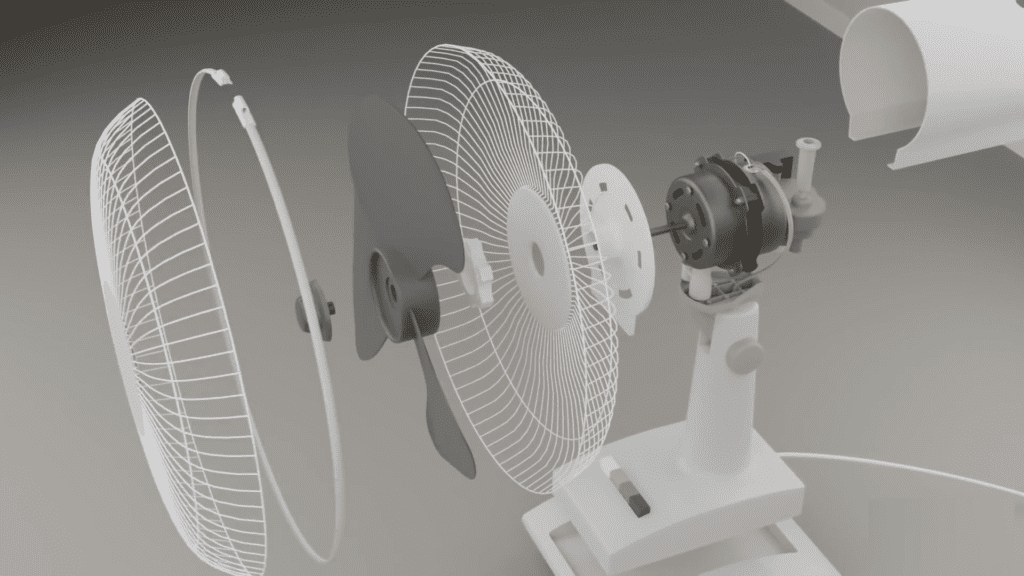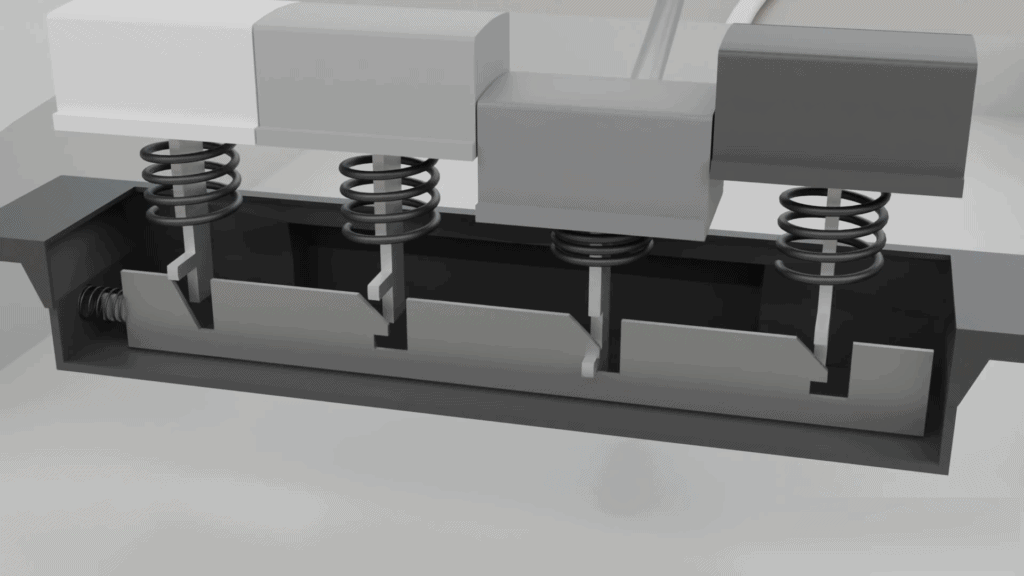Fans are necessary on sweltering summer days to keep you cool. There are different types of fans that create a cooling breeze in different situations. There are fans that are worn around the neck when we are outdoors and can be used hands-free. There are mini desk fans that are powered by a laptop in the office and direct the airflow directly to the face and neck.
There are fans that are designed to cool a larger area – a whole room – so that more people can benefit from their effect. This important feature becomes possible when the fan rotates or oscillates. In this way, the air flow is directed to a much larger area of the room.
What is an oscillating (rotating) fan?
Oscillating fans rotate from side to side while blowing, as the word oscillation stands for—movement back and forth in a regular rhythm. The oscillating fans are also called rotating fans, and for this feature, they differ from stationary fans that have a fixed head and blow in just one direction.
Oscillating fans provide a cool effect in a wider space in a room.
Rotating fans usually have either a base or stand that is stationary, while the unit housing the fan moves separately. The blowing heads of some fans can be pivoted up and down, and this way, the cool airflow can be directed more precisely.
Who invented the oscillating fan (mechanized fan evolution over time)?
Before explaining how oscillating fans work, we should briefly review the story – how fans were mechanized. This will help us build the model and understand the mechanism of how oscillating fans work.
People living in hot climates adore the cooling relief that winds provide. And when there is no wind, they find out how to create it. In ancient Egypt, servants fanned their masters with palm leaves.
Later on, fans with various designs were produced, some of them made of ornate materials such as gold filigree or carved mother-of-pearl. Such exquisite fans were found in the tomb of Tutankhamun, elaborately made of gold that also contained remnants of ostrich feathers.

The first known mechanical fan is the punkah fan, which was used in India around 500 BC. It was a hand-held fan made of bamboo strips or other plant fibers that could be twisted or fanned to move air. During British rule, the word was used by Anglo-Indians to refer to a large, swinging, flat fan attached to the ceiling and pulled by a servant called a punkawallah.

The Chinese also had experience with the mechanization of the fan. Around 180 AD, the famous Han Dynasty inventor Ting Huan developed a rotary fan with seven wheels, each 10 feet in diameter, with which a single man could cool an entire hall. Later, rotary fans were used not only for cooling but also for ginning grain and ventilating mine shafts.

The first patent of a fan driven by a system or a mechanism was filed on November 27, 1830, by James Barron. He submitted a drawing with his patent application for an improvement in ventilators. In his application, he states that this fan is not only suitable for bedrooms but can also be used in dining rooms and halls. He was granted a patent on November 27, 1830.

The original drawing of this patent was destroyed in a fire at the patent office in 1836. The cover date is the date of the original patent. This drawing is a restoration made in 1837 or shortly thereafter.
In the 1850s, before electricity made its way into household appliances, people produced the idea of using steam or water turbine fans. A belt connected a network of fans that were used to cool the interiors of large rooms.
This system was widely used in the southern states of the United States. John and James Hunter, a father-son duo, built a ceiling fan driven by a water turbine in 1886, a few of which still survive, although they are no longer in use. It is unlikely that ceiling fans could be purchased in stores at this time.
The first electric fan was invented by Schuyler Skaats Wheeler in 1882. He placed a two-bladed propeller on the shaft of an electric motor. It became popularly known as the “humming fan.” In 1904, the Franklin Institute awarded him the John Scott Medal for developing the “electric fire extinguishing system.”
The first electric ceiling fan and the first oscillating fan were invented by Philip H. Diehl. He mounted a fan blade on a sewing machine motor and attached it to the ceiling. He thus invented the ceiling fan, for which he applied for a patent in August, which was granted on November 12, 1889. He later added a lighting device to the ceiling fan.
In 1904, Diehl and Co. added a ball joint that allowed the fan to be reversed; three years later, this developed into the first oscillating fan.
The first oscillating fans were developed in 1907, based on a concept for ceiling fans.
Until then, all electric fans were like ceiling fans, meaning they could direct air in only one direction. The electric fans quickly took over the market, but they had a main problem when used as a table, meaning they could only cover one direction.
Engineers found a way to improve on the original electric fan design by adding a split ball joint that allowed the fan to be deflected and manually redirected. This was a great improvement over earlier fans that blew in only one direction.
The design was further improved by mechanizing the directional control of the fan. By moving the head of the fan from side to side, the new fan could effectively direct the breeze in more than one direction. Thus, the first version of the modern oscillating fan was created.
Over the years, several other improvements to the electric fan have been developed. There are models that also have a built-in electric heating system. These heat the air and expel it, creating a warm, thawing wind.
Most oscillating fans are used to provide a cool breeze in homes, offices and other indoor spaces. The most advanced electric fans bend the air in different directions as they expel it, covering the entire room and eliminating the mechanical motion typical of conventional oscillating fans.
How do oscillating fans work?
Inside oscillating fans are some neat mechanisms, especially the gears and levers that cause the fan to oscillate back and forth:




Before we dive into details, let us take a look at the key features of an oscillating fan. At the bottom are the buttons to set the fan speed. On one of the sides, there is a dial to set the pitch of the fan. And there is a pin on top to make the fan move back and forth.




There are several screws in the bottom and plastic pieces to take off. The coolest parts are at the top:




Let us start with the buttons. There are 4 buttons and 3 speeds, and then the white one turns off the fan. Each time you press down a button, the previous ones are released. The white button turns the fan off and, besides the other buttons – does not stand down. When you press it – it automatically turns up.

And, of course, this is driven by a mechanism. Each button has a spring underneath that wants to push the button back up. Inside is a metal plate with a few jagged cuts going down. The metal plate is being pushed to the right by another spring on the left side.



By pushing down a button, the plate slides to the left. If you push far enough it clicks into place, preventing the button from coming back up. If you press down another button the plate slides enough to release the first button.
The sole reason for the white button is to release any of the other buttons. There is no notch to hold the white button down. Releasing the other buttons will turn off the fan.

Three color-coded wires come out at the back of the buttons. Whichever button is pressed sends a signal up the wire to the top of the fan, telling the motor to start the fan spinning at whatever speed we choose.
At first, the fan will only be pointed in one direction. But if we want to cool off more of the room, the pin should be pressed, and the fans start oscillating or, in other words moving back and forth.
We already have an electric motor and don’t want another one. The idea is to convert the spinning motion of a fan into a side-to-side motion. And here is the concept that stands behind this.

It is called a four-bar mechanism. Each bar is connected by pins which allow them to rotate freely. One of the bars (green) is usually fixed in place and cannot move. The yellow one is called the crank. Usually, a motor is causing it to rotate around. The other two bars are caused to follow the motion.
By changing the length of these bars, we can get some different motions. Usually, the green bar is fixed in place. But what if the small blue bar is fixed – the motion is completely different. And this is how we get the oscillating motion of the fan.



And here comes the question – how do you convert the rotation of the fan to the rotation of the crank? The magic happens inside of the gear box. There’s a piece that sticks out the back that rotates along with the fan. It is called the worm



When the worm spins it kind of look like it’s moving even though it’s not. Right next to it is the worm gear. Down blow is another gear which is directly attached to the crank. And the pin is what connects these all gears together and has some gear teeth on it.


Towards the top of the pin there’s a spring with two ball bearings. They come out just far enough to catch the worm gear and spin with it. The rotation is on when the pin is down. When the pin is up, the fans is stationary
Types of rotating fans to buy
There is a large variety of rotating fans with different sizes and different settings. There are small ones to be placed on the table in front of the people who need to cool off powered by the laptop, batteries or plugged in the electricity grid.
Most of the pedestal misting fans that use water evaporation to provide cooling in regions with hot and very dry climates usually adopt the oscillating technology to cover a wider area outdoors – in the garden, on the patio, having fun on the beach, having picnic with friends, summer camping wth the family, while grilling, etc.
There are larger pedestal ones, standing on the floor that cover a wider space of the room to chill out for more people. Some oscillating fans combine heating and cooling options. Some combination models even have digital thermostat control for heating operation.
Choosing the right one estimate the size, the power supply options, the length of the cord, the noise emitted, how powerful the airflow is, the speed options and tilt options (pivoting head up and down).
For smaller rooms and personal use, a mini table fan will be an excellent choice, but for bigger rooms – consider buying a bigger pedestal (tower) fan.
